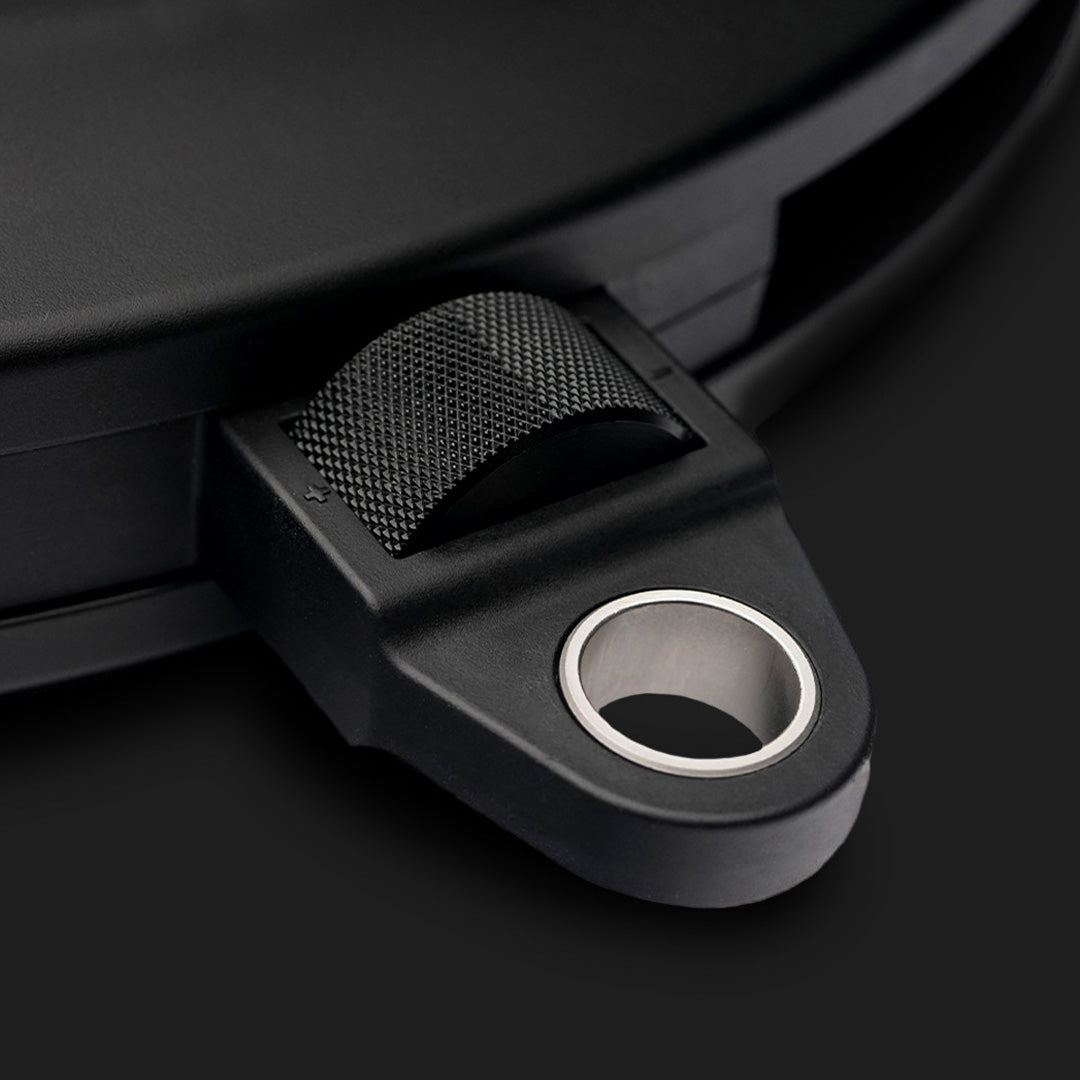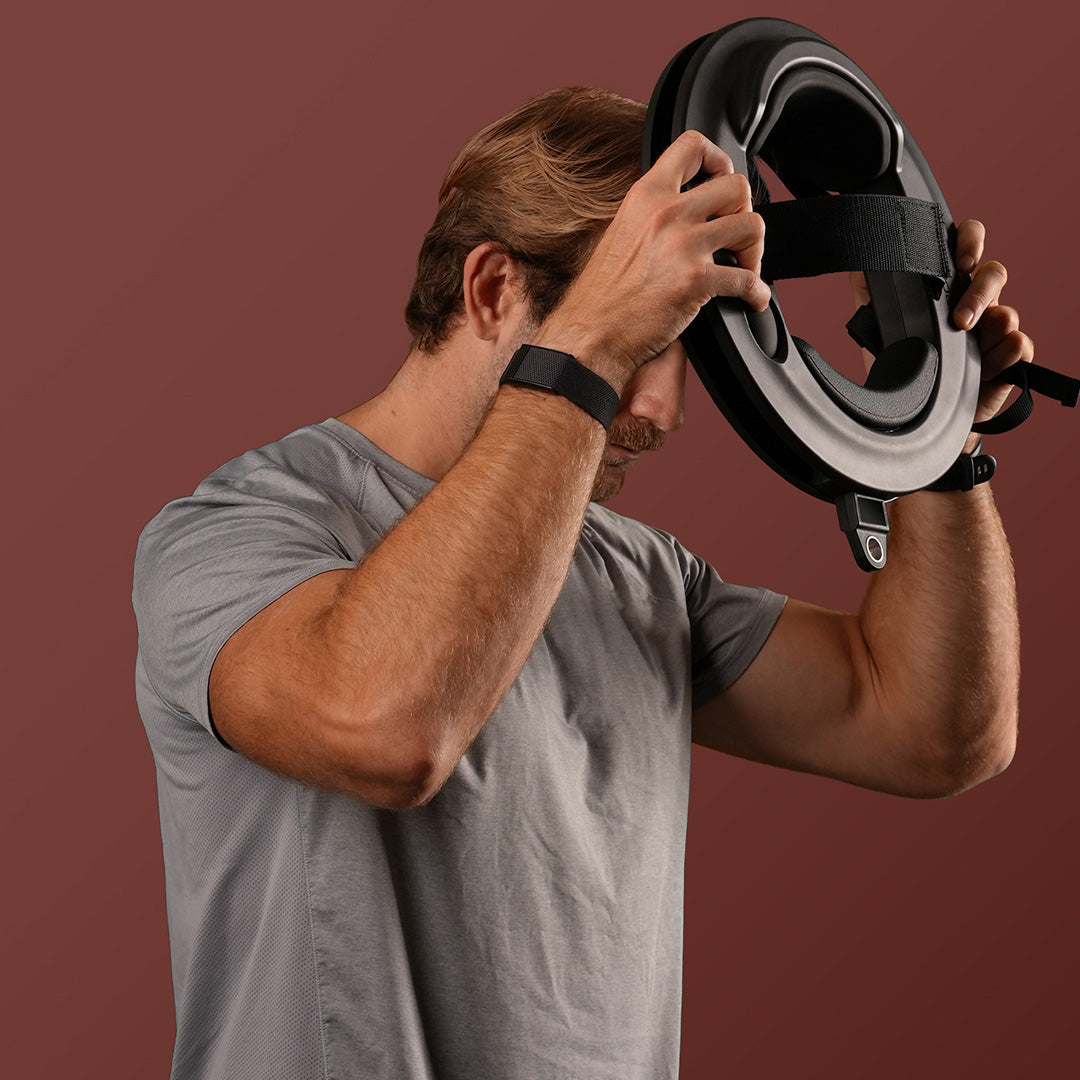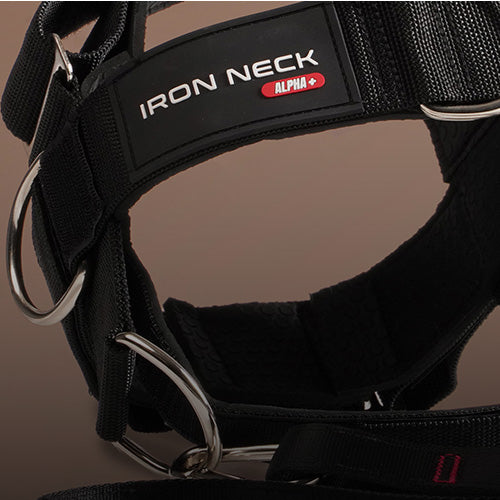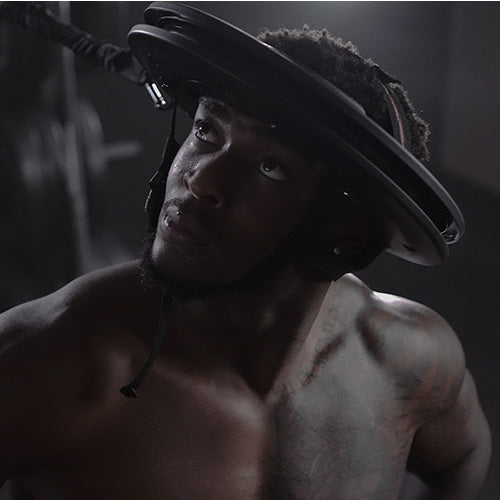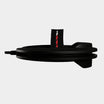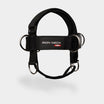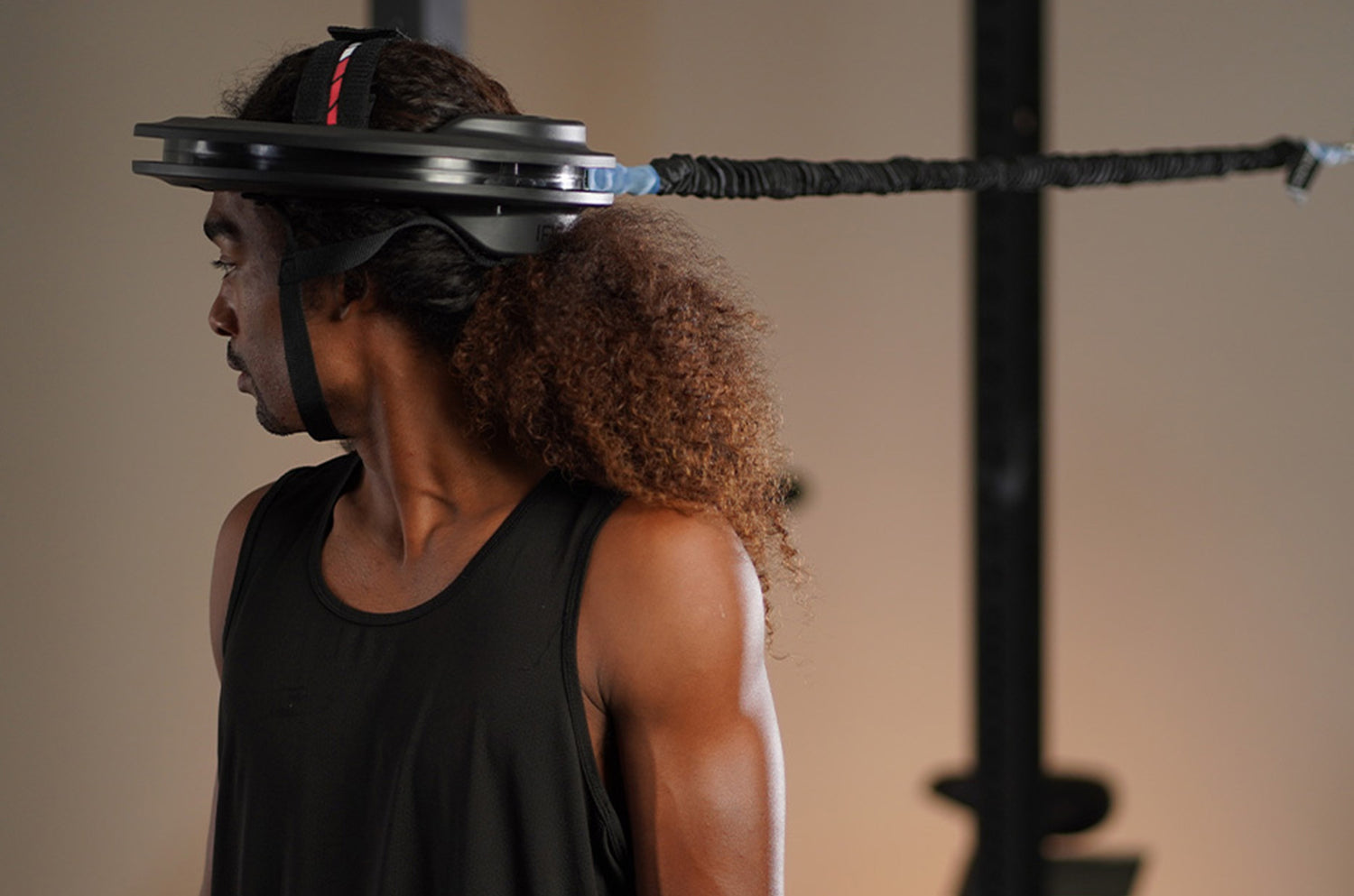Whether you've felt that sudden twinge of pain from quickly turning your head or you simply want to maximize your neck's strength and flexibility, understanding neck rotation is essential.
This is more true than ever in the modern, digital age where the vast majority of individuals neglect neck strength and mobility. The end result is a society with thin, weak, immobile pencil necks.
This leads to poor athletic performance, pain and discomfort while driving or sitting in front of your computer, and a host of other problems.
The good news? Incorporating neck rotation exercise movements into your training regimen can help you enhance daily functionality, boost athletic skills, and radiate confidence in every stride you take.
Discover the role neck rotation plays in your day-to-day life below as we walk you through some of the benefits of training this movement pattern along with advice on adding it to your workout regimen.
What is Neck Rotation?
Ever stood at a bustling intersection and instinctively turned your head to catch a glimpse of an oddly loud noise?
Or maybe while seated, you've pivoted your head to engage in a conversation with someone next to you.
Perhaps you play a sport where “having your head on a swivel” is paramount to keeping yourself safe and making the right play in a big game.
These simple yet crucial movements are courtesy of the neck rotation ability. Let’s take a look at the neck muscles anatomy as it pertains to rotation and discuss the muscles involved.
Anatomy of Neck Rotation
Neck rotation involves the head turning to the left or right while the spine remains stationary. This movement hinges primarily on the upper cervical spine - especially the atlas (C1) and axis (C2) vertebrae.
These two bones form a unique partnership allowing us to nod and shake our heads. The atlas spins around the axis, granting our neck a remarkable range of motion.
The Role of the Lateral Neck Muscles
Supporting this intricate dance of bones are the muscles of the neck - specifically, the lateral neck muscles. These side of neck muscles are the unsung heroes when we swivel our heads. Two primary muscles play a starring role:
- Sternocleidomastoid (SCM): This muscle has its origins in the sternum and clavicle and attaches to the mastoid process of the skull. The head rotates to the opposite side when one SCM contracts.
- Splenius Capitis: This muscle is found at the back of the neck and runs obliquely from the upper thoracic and lower cervical vertebrae to the temporal bone of the skull. It works synergistically with the SCM, aiding in turning the head to the side.
These muscles work in synergy not only to facilitate rotation but also to ensure our neck remains stable, reducing the risk of injury when subjected to sudden movements or forces. Let’s progress the conversation further by unpacking all the benefits of neck rotation exercise movements.
Benefits of Neck Rotation Exercise
The benefits of training neck are profound - not just for serious athletes but for anyone who values a pain-free lifestyle.
Athletic and Sports-Related Benefits
Every sport, from tennis to basketball to golf and beyond, relies on the fluid movement of the neck. When you serve an ace or shoot a three-pointer, your neck's rotation guides your vision and aids your precision. Enhancing neck rotation translates to:
- Improved Field of Vision: See more of the game around you, anticipate opponents' moves, and make quicker decisions on the fly.
- Enhanced Reaction Time: With a supple neck, you can respond rapidly to a fast-moving ball or an unexpected play.
- Reduced Injury Risk: A strong and flexible neck can better absorb shocks, reducing the risk of concussions and whiplash injuries in contact sports.
Aesthetic Advantages: Sculpting a Defined Neck
A well-defined neck isn’t just about looking good - it signifies strength and health. Regular rotational neck exercises can help:
- Chisel the Neckline: Create a more defined separation between the neck and jaw, offering a more youthful and athletic appearance.
- Reduce Appearance of Neck Fat: You can combat the sagging that sometimes appears with age or weight fluctuations by toning the neck muscles. You can learn more about neck skin tightening exercises like these turkey neck exercises and other exercises for neck fat we have written about.
- Boost Confidence: A strong neck can help you maintain proper neck posture, making you stand taller and prouder. We have resources talking specifically about how long does it take to correct forward head posture and exercises for forward head posture.
Health and Wellness Perks: Reducing Pain and Boosting Mobility
The intrinsic health benefits of neck rotation exercises extend beyond aesthetics and athletic performance:
- Pain Alleviation: Regular rotation exercises can mitigate the stiffness and discomfort that comes with sedentary lifestyles, helping to reduce chronic pain episodes.
- Increased Mobility: Whether it's looking over your shoulder while driving or reaching up to a high shelf, a mobile neck makes everyday tasks easier. We’ll talk about a few neck mobility exercises specifically in just a moment.
- Improved Blood Flow: Neck exercises promote circulation, ensuring essential nutrients reach the muscles and facilitating faster recovery from strains.
The Top Neck Rotation Exercises Performed With Iron Neck
You’re likely all in on rotational neck exercises upon discovering the benefits of training this movement pattern. The question is, how do you actually perform “neck rotation” movements? The experts at Iron Neck are here to help.
Below, we’ll walk you through the top neck exercise rotation movements you can add to your regimen. But first, let’s talk about why you need to invest in the best neck exercise equipment if you’re serious about your goals.
Why Train Neck Rotation With Iron Neck?
Quality, consistency, and the right equipment can make all the difference when it comes to neck rotation. And that's where the Iron Neck comes into play.
This revolutionary tool is a game changer in the realm of neck training. You can use it to elevate your rotational neck exercises to a new level of effectiveness and safety, making weak neck muscles a concern of the past.
But, what makes our neck machine a must-have in your arsenal? As it pertains to the topic of neck rotation, the key is in the ability to target neck muscles from 360 degrees. This just isn’t feasible with your standard neck workout harness. The machine also comes equipped with a variable friction dial.
You’ll find the Iron Neck in NFL training facilities, physical therapy rehab centers, and home gyms around the world. There’s a reason it’s become synonymous with neck training. Get yours today and see what it can help you achieve - with a 30-day money-back guarantee, what do you have to lose?
Get your order placed and while you’re awaiting delivery you can start practicing the top three neck rotation exercises below.
Look Left, Look Right Exercise
This is the fundamental rotation movement, and it’s where we recommend you start your training so you can get the movement pattern down and build those tiny muscles from the ground up.
- Starting Position: Stand upright with the Iron Neck secured. Ensure it's comfortable and in a neutral position.
- Movement: Slowly turn your head to the left as far as you can without straining. The resistance provided by the Iron Neck will engage the muscles effectively. Your goal should be to get your chin parallel with your shoulder - but don’t push through pain if you don’t have the mobility in place yet.
- Return: Gradually rotate your head back to the center.
- Repeat: Now, turn your head to the right, experiencing the same controlled resistance. Thus, the name “look left, look right”.
Diagonals Exercise
This movement provides a comprehensive workout, combining both rotation and tilt, ensuring a dynamic range of motion for the neck muscles. It takes things a step further while also challenging you mentally:
- Starting Position: As always, begin with the Iron Neck snugly fit and in a neutral forward-facing position.
- Movement: Instead of a flat left or right rotation, turn your head diagonally upwards to the left. You should maintain central head alignment while turning your head 45 degrees. The distinction between this movement and “look left, look right” is in where your gaze should fall. You’ll end up looking up at the ceiling and then down toward the floor with this neck rotation exercise.
- Return: Slowly come back to center before continuing your gaze downward toward the floor. That’s one rep.
- Repeat: Perform the same movement but diagonally upwards to the right.
Figure Eights Exercise
This is the most advnaced neck rotation exercise, and one we recommend you practice without resistance first to get the movement pattern down.
- Starting Position: Stand upright with the Iron Neck comfortably placed and maintain a straight posture.
- Movement: Begin by tilting your head diagonally upwards to the left, then sweep it down (imagine drawing a half-circle) and move it diagonally upwards to the right.
- Complete the Figure: Now, from the top right position, sweep it down and move it diagonally upwards to the left. Envision your nose as a pen, and think about drawing a figure eight - this should help you get the movement pattern down.
Making Neck Rotation a Part of Your Regular Training Regimen
Consistency and a well-planned regimen are paramount to getting the neck training results you crave. So let’s progress this conversation beyond just breaking down neck rotation exercises. Here are some additional tips on how to train your neck.
Reps, Sets, Frequency, and Resistance
Figuring out which rotational neck exercises to perform is step one - but then, you have to figure out how it fits into your training regimen. Here are a few things to consider:
- Repetitions and Sets: Consider 2-3 sets of 8-12 repetitions for each exercise when first starting out. This range generally hits the sweet spot of building strength without overwhelming the muscles.
- Frequency: Aim to incorporate neck exercises into your routine 2-3 times a week. This frequency provides a balance, allowing muscle growth while also giving the neck ample time to recover. Learn more in our guide on how often to train neck.
- Resistance: You can adjust resistance levels with Iron Neck to match your current strength. Always start with a comfortable resistance, focusing on form, before gradually increasing as your neck gets stronger.
Applying the Principles of Progressive Overload
Progressive overload is the gradual increase of stress placed upon the body during training, ensuring continuous growth and avoiding plateaus. This means incrementally increasing resistance or repetitions over time.
You may find that you can handle more resistance or perform more repetitions without fatigue as you progress with your Iron Neck training. It's essential to monitor your body's response and adjust accordingly, always prioritizing form over sheer weight or reps.
Other Non-Rotational Exercises You Can Do With Iron Neck
Beyond rotations, the Iron Neck offers a plethora of exercises to target various parts of the neck and upper spine. Here are some of the best neck exercises for mass that the Iron Neck supports:
- Neck Flexion: This exercise strengthens the front of the neck. It's essential for anyone regularly looking down, like when reading or using a smartphone.
- Lateral Neck Tilt: This targets the sides of the neck which is crucial for movements like checking your blind spot while driving.
- Isometric Holds: Resist movement in a particular direction, holding the neck stable, to challenge and build neck strength without moving.
- Neck Protraction and Retraction: These exercises are excellent for posture, especially if you find yourself slumping or leaning forward regularly.
You should incorporate a blend of movement patterns into your at home neck workouts to prevent imbalances from forming. This will set you on a path to a stronger, more resilient neck that supports all your daily activities and athletic pursuits.
But, you came here specifically to learn about rotational neck exercises. And now that we’ve covered everything you need to know to get started, it’s time we bring this conversation to a close.
Bringing Our Conversation on Neck Rotation Exercise to a Close
We’ve journeyed through the intricacies of neck rotation, its undeniable benefits, and the optimal exercises to harness its power. We hope you feel confident in adding these neck rotation exercises to your training regimen after reading this guide.
You can learn more about how to get a thicker neck in our blog. We have resources on neck spasm exercises, why your shoulders are always tense and raised, neck arthritis exercises, cervical vertigo exercises, how to relax neck muscles, neck exercises for dizziness, neck stability exercises, and more.
By understanding and implementing effective neck training, especially with tools like the Iron Neck, we empower ourselves for a future with more strength, flexibility, and less discomfort.
As we wrap up, remember: your neck holds up your world. Give it the care, attention, and training it rightfully deserves. Get the #1 alternative to neck harnesses today and set yourself up for success as you begin building neck muscles..


